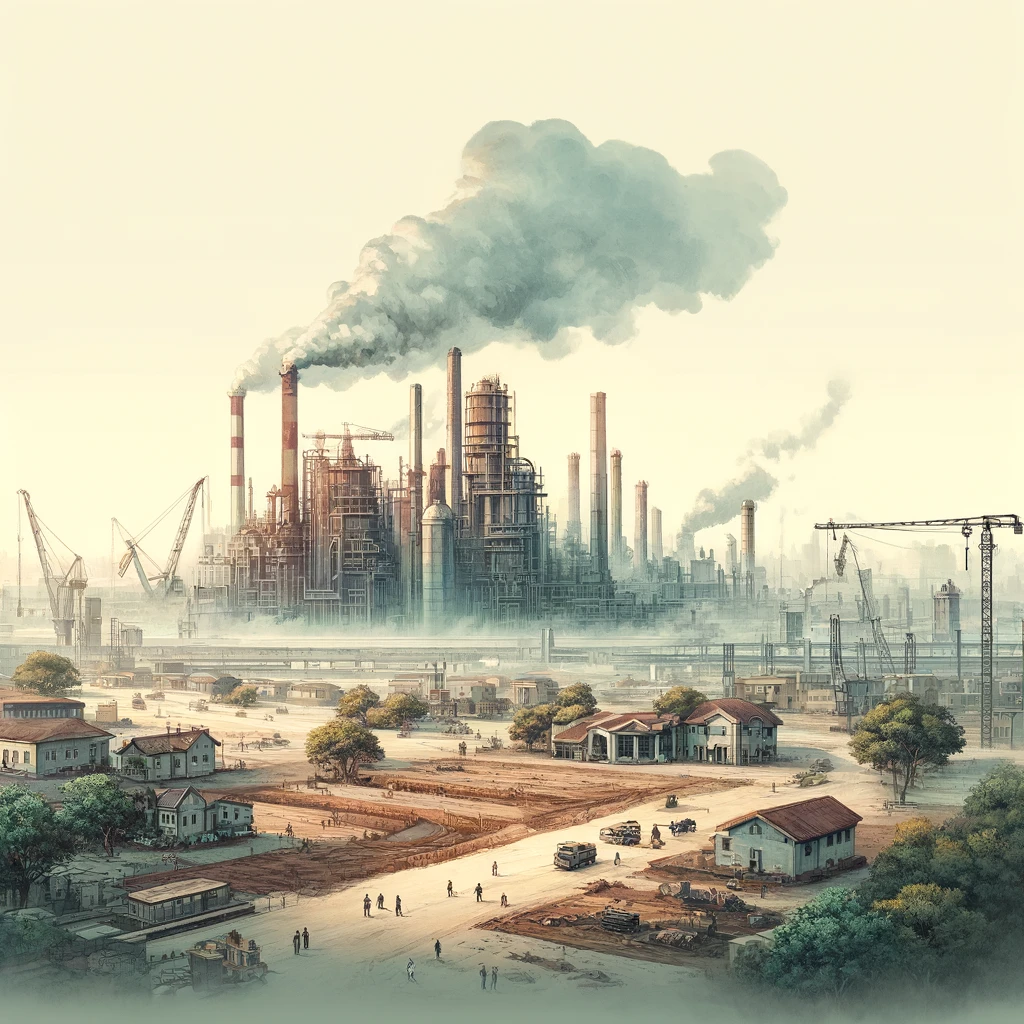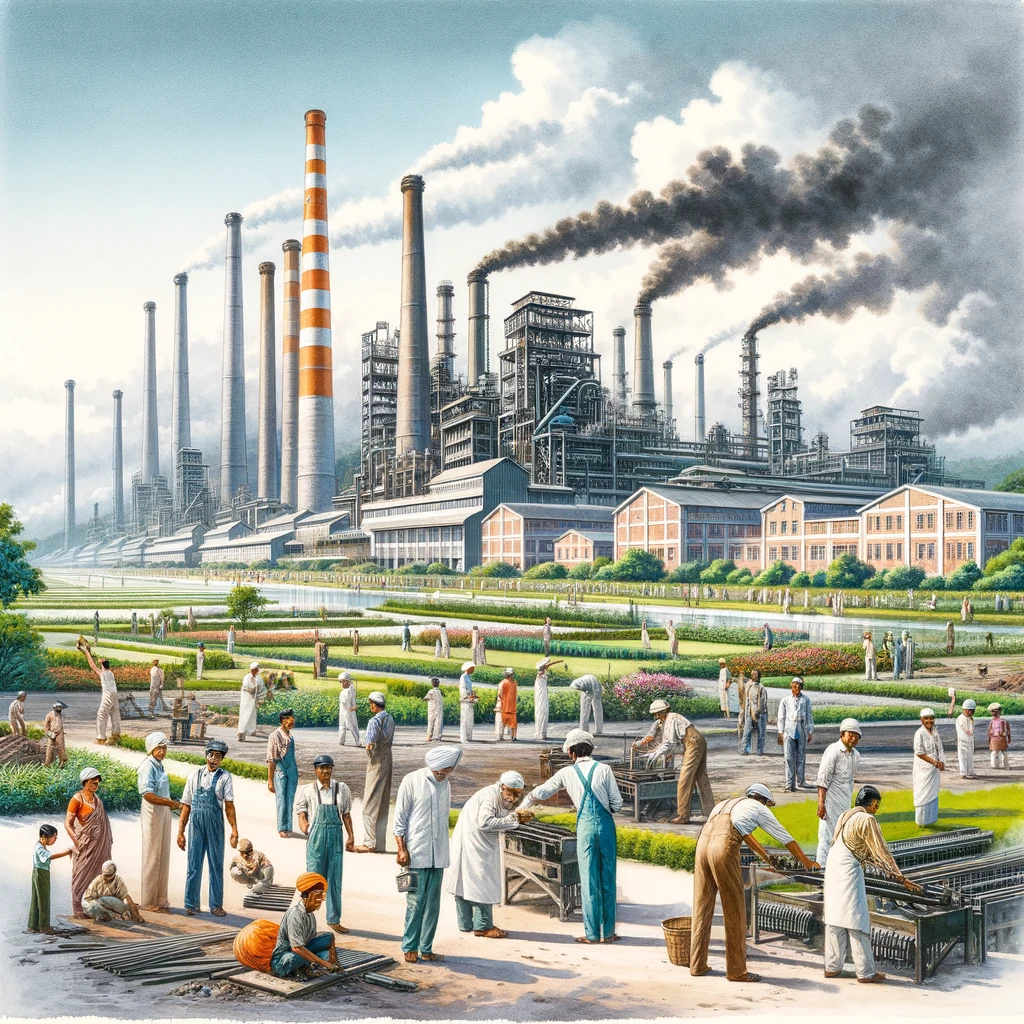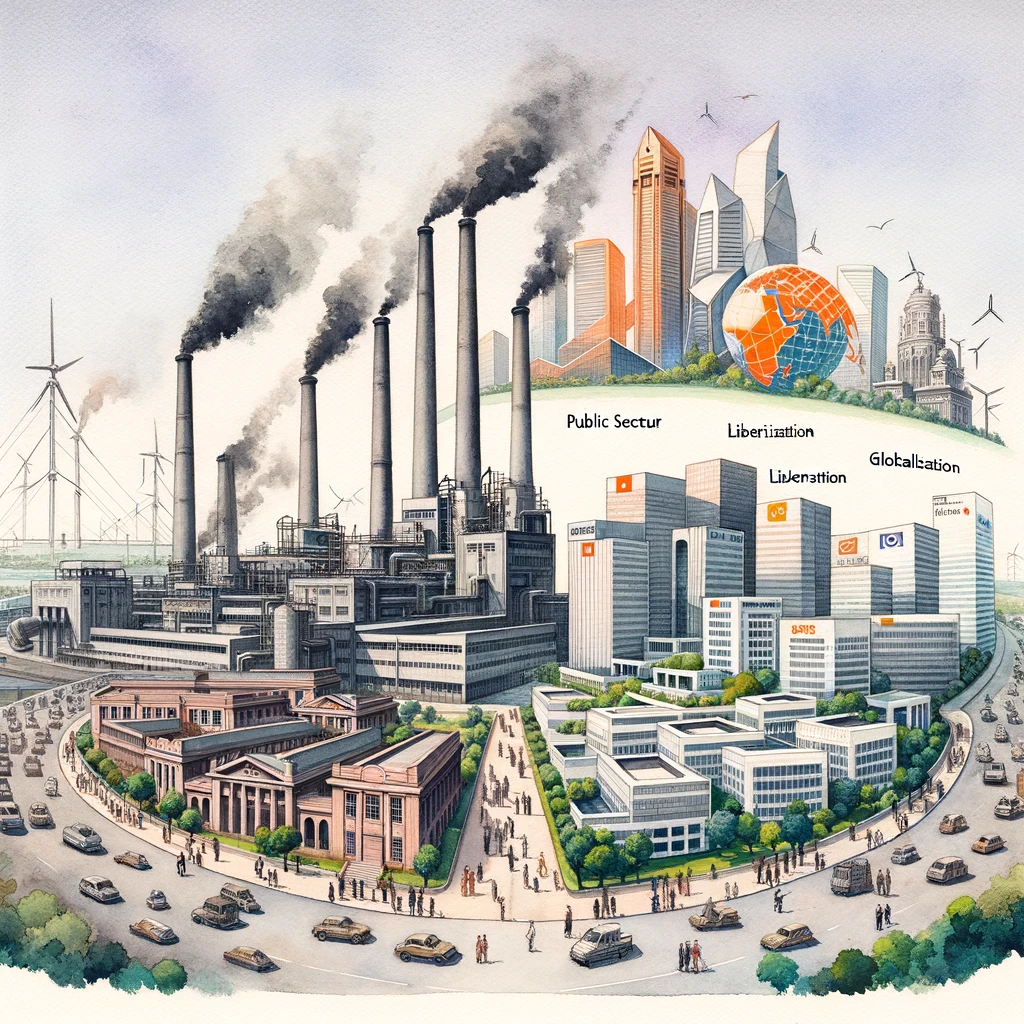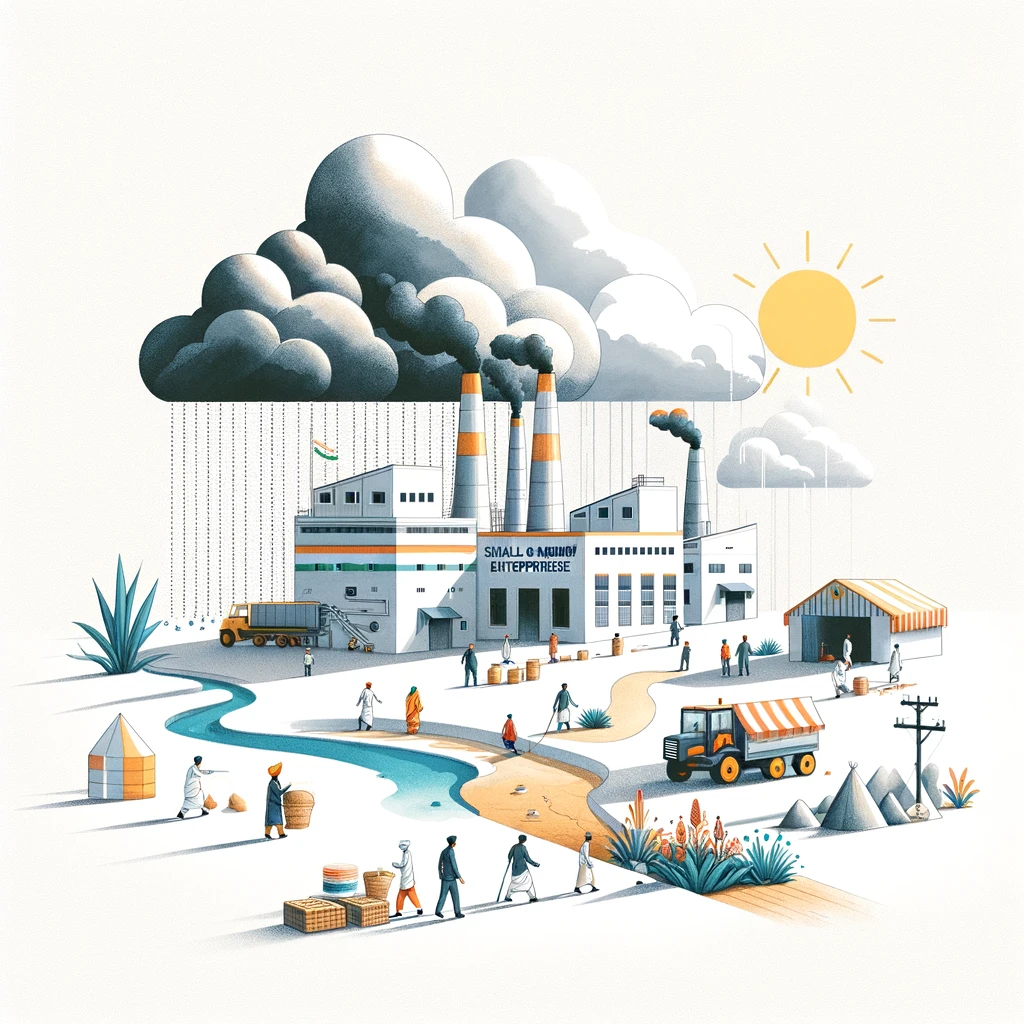Industrial Development in India, post-Independence has played a significant role in shaping the country’s economy. After gaining independence in 1947, India adopted a mixed economy model, blending both public and private sectors. The government aimed to reduce dependence on agriculture and boost industrialization through various five-year plans, focusing on sectors like steel, coal, and heavy engineering. This transition laid the foundation for a more diversified and modern economy.
- Government introduced policies promoting industrialization and establishing public sector units across critical industries.
- The first five-year plan focused on infrastructure, energy, and industrial capacity development.
- Private sector participation increased gradually, with more liberalization policies in the 1990s.

Historical Background of Industrialization in India
Public Sector Dominance (1947-1991)
The post-independence government of India followed a socialist-inspired mixed economy. This led the state to assume a great role in economic activities to take the country towards development. The period can be divided into various key policies and events:
- Industrial Policy Resolution of 1948 and 1956: The industrial policy resolution of 1948 and that in 1956 provided a platform for the Indian industrial policy. The resolution in 1956 specifically identified public sector enterprises in critical industries. Industries were divided into three schedules:
- Schedule A: Totally reserved for the state sector like defense, atomic energy, and railways.
- Schedule B: State sector with permission to the private sector.
- Schedule C: The private sector was permitted with state support.
- Five-Year Plans: Five-Year Plans started with the First Plan (1951-1956) by developing a solid framework of industries. The model of Mahalanobis shaped the Second Five-Year Plan (1956-1961) wherein major emphasis went to heavy industries. The subsequent plans allowed the PS sector to mushroom through PSEs such as the steel plants of Bhilai, Rourkela, and Durgapur, mining, and heavy machinery.
- Import Substitution Industrialization (ISI): To minimize dependency on imports, the government followed a policy of high import tariffs and other import restrictions to safeguard the newly emerging domestic industries. However, this policy was supposed to make the economy self-sufficient but most often resulted in inefficiency due to lack of competition.
- Public Sector Enterprises (PSEs): PSEs were set up in almost all the sectors. By 1991, around 240 PSEs were there and were providing employment to over 19 million people and adding a substantial value to GDP.
Liberalization and Globalization (1991-Present)
In the face of a severe balance of payments problem in 1991, India was compelled to pursue a series of liberalization measures. The features and consequences of this period are as follows.
- New Industrial Policy of 1991: In this policy, it was formulated to lower the level of governmental control over industries and enhance private investment.
- Trade Liberalization: Reduction in the tariff barrier and quantitative restrictions on imports brought India into the world economy. This led to an escalation in imports and exports with trade as a percentage of GDP having increased from 15% in 1991 to above 40% in recent years.
- FDI Inflows: Liberalization of FDI policies brought in a significant foreign capital inflow. From just $132 million in 1991, FDI inflows increased to $50 billion in the year 2020-21.

Role of Major Industries in Economic Growth
Key sectors driving the Indian Economy
- Textile Industry: Contributes to a workforce of more than 45 million, accounts for 7% of the industrial output, and 2% of GDP. Further, adds up to 15% of the total exports. The textile industry is one of the most vital sectors for garnering the much-needed foreign exchange.
- Automobile Industry: Automobile is another big industries which contributes significantly to the economy of India. India ranks fourth among the automobile markets in the world, with automobile production of over 26 million vehicles during 2019-20. The industry also accounts for 7.1 per cent of the country’s GDP and employs about 32 million people, both directly and indirectly.
- Information Technology: IT is a sector, which has been a spearhead of India’s economic transformation. The share of IT in the overall economy of India is about 8% and it provides employment to over 4 million professionals. In the year 2020, IT exports, mostly in terms of software services, were valued at USD 150 billion.
- Pharmaceutical Industry: The pharmaceutical sector accounts for about 2% of India’s GDP and gives direct employment to around 2.7 million people in the country as it is among the largest generic producers in the world. This industry’s exports stand at $24.4 billion for 2020-21.

Challenges Faced by Industrial Sector
India’s industrial sector is still facing several major challenges despite this growth:
- Infrastructure deficiency, particularly transportation and power, is a major bottleneck. Infrastructural deficits are estimated by the World Bank to cut India’s GDP growth by 1-2% every year.
- Regulatory Barriers: The regulatory complexity and bureaucratic inefficiency discourage investment. India ranks 63rd out of 190 countries in the Ease of Doing Business Index of the World Bank.
- Skill Gaps: A high level of graduates does not get employment also due to mismatch between the output the education system is producing and the requirements of the industry. According to reports, it has been quoted that only 25 percent of Indian engineers are employable in the IT sector without additional training.
- Availability of Finance: MSMEs, which constitutes the backbone of the industrial sector, are deprived of proper finance. The credit gap of Indian MSMEs is estimated at $230 billion as documented by the International Finance Corporation.
- Environmental Factor: Industrial activity has always been one of the major causes of pollution and environmental degradation. India is ranked 168 out of 180 countries in the Environmental Performance Index 2020, thus requiring sustainable factors.
- Future Prospects and Policy Recommendations
- Indian growth needs strategic policy interventions to become sustainable. These include the following:
- Infrastructure: There is a great need for investment in modernization and expansion, in order to create more infrastructure. According to the National Infrastructure Pipeline, an investment of over $1.4 trillion by 2025 will uplift logistics, transportation, and energy sectors across the country.
- Ease of Doing Business: Reforming procedures, increasing transparency, and ensuring timely implementation of reforms are highly required. Initiatives like the Insolvency and Bankruptcy Code (IBC) and Goods and Services Tax (GST) are in the right direction.
Conclusion
Many years have elapsed since India attained independence, where the country’s industry has also experienced a transition from a state-dominated model towards an open one integrated with the global markets. Struggling through several constraints, strategic policy interventions such as infrastructure development, regulatory reforms, skill development, innovation, and sustainability can scale up the potential of the sector for economic growth and development.
| Industrial Development in India UPSC Notes |
| 1. Industrial development in India post-independence focused on building a self-reliant economy with key sectors like steel, cement, and energy. 2. The Five-Year Plans played a crucial role in promoting industrialization, with the second plan emphasizing heavy industries and public sector growth. 3. Public sector undertakings (PSUs) were established to lead industrial growth in sectors like steel, mining, and manufacturing. 4. Liberalization in the 1990s marked a shift towards privatization, foreign direct investment, and reducing government control over industries. 5. The Green Revolution contributed to the growth of agro-based industries, enhancing food production and rural industrialization. 6. The Industrial Policy of 1956 laid the foundation for the mixed economy model, encouraging both private and public sector growth. 7. Infrastructure development, such as transport, energy, and telecommunications, facilitated industrial expansion and economic integration across India. 8. Small-scale industries and micro, small, and medium enterprises (MSMEs) gained prominence, contributing significantly to employment and GDP growth. |


